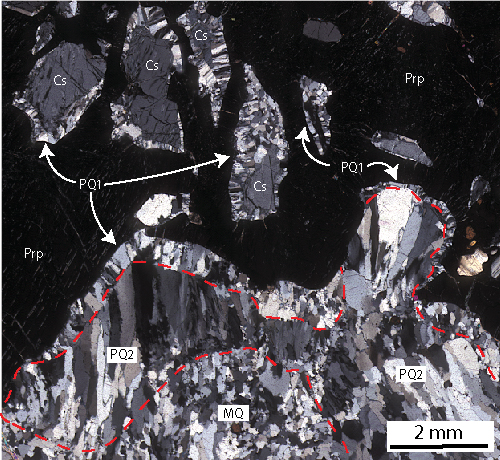Step-by-step microstructural characteristics of coesite-quartz phase transition during exhumation of UHP white-schists from Dora Maira Massif, Western Alps
- 1Faculty of Geology, Geophysics and Environmental Protection, AGH University of Krakow, Poland
- 2Department of Geology and Paleontology, Faculty of Natural Sciences, Comenius University Bratislava, Slovakia
- 3Department of Earth Sciences, Uppsala University, Uppsala, Sweden
Ultra-high pressure (UHP) complexes are crucial in comprehending dynamic orogenic processes. One of the most representative UHP mineral in such rocks is coesite, which is on the other hand unstable in lower (near-surface) conditions and undergoes a rapid transformation to quartz. The objective of this study is to gain insight into the retrogressive development of quartz microstructures and the phase transition of coesite to quartz. New analyses of quartz surrounding a relict coesite inclusion in garnet and pseudomorphs in the rock matrix from the Dora Maira white schist (pyrope quartzite) are presented. The analyses include electron backscatter diffraction (EBSD), scanning acoustic microscopy (SAM), cathodoluminescence (CL), and misorientation analysis. The white schist contains quartz in a variety of forms, including single grain inclusions, fringes of palisade quartz surrounding coesite inclusions, and palisade/polygonal textures in the matrix. The microstructures were characterized using EBSD. In quartz grains, EBSD orientation maps can reveal intracrystalline deformation features in addition to grain reconstruction. Quartz grains form multiple microstructurally distinct domains. I) A thin rim of perpendicularly growing palisade quartz surrounds primary coesite single crystal – PQ1 (Fig. 1); II) Large grains (0.2-1.5mm) of palisade-type quartz, in direct contact and often sharp boundary with the rim of the first-type microstructure – PQ2 (Fig. 1); III) Fully recrystallized polygonal texture matrix – MQ (Fig. 1). Two distinct positions are observed in the PQ1 microstructure. In the first position, PQ1 typically forms a thin rim around the coesite inclusion in direct contact with the surrounding pyrope garnet. In the latter position, it forms thin boundary between porphyroblasts of garnet and the PQ2 microstructure (Fig. 1). The shape of the 0.005 to 0.1 mm wide PQ1 grains is generally perpendicular to the boundaries with coesite and garnet. The PQ2 microstructure is observed in the location of second-generation palisade quartz, which has undergone grain boundary migration recrystallization mechanism. The final type of microstructure exhibits a typical polygonal texture, with sharp grain boundaries and uniform grain size (Fig. 1), indicative of fully recrystallized matrix. A prerequisite for the study of CL was the assumed zonation and a discernible difference in microstructures. However, this was not confirmed, and the differences in microstructures are not clearly discernible in CL. On the other hand, CL can be used as a quick and simple tool to find or confirm coesite that is significantly brighter and distinguishable from its surroundings (including quartz). The study of quartz using SAM also reveals differences in microstructure. However, this method is still in the preparation and calibration stage and may yet prove useful in the study of decompression in UHP rocks.

Figure 1. Different types of quartz microstructures.
Acknowledgements:
Funded by the National Science Centre of Poland (project 2021/43/D/ST10/02305)
How to cite: Potočný, T., Kośmińska, K., and Majka, J.: Step-by-step microstructural characteristics of coesite-quartz phase transition during exhumation of UHP white-schists from Dora Maira Massif, Western Alps, 16th Emile Argand Conference on Alpine Geological Studies, Siena, Italy, 16–18 Sep 2024, alpshop2024-73, https://doi.org/10.5194/egusphere-alpshop2024-73, 2024.
